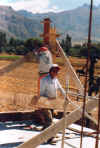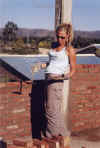welcome to worldwidewachs.com
BOLIVIA: 28 MAY 03 TO 18 NOV 03
May 28, 2003
We are in the Springfield airport awaiting the first of several flights on our way to be volunteers with the Amizade organization in Cochabamba, Bolivia.Now is the transition period, the in-limbo state of suspension when you have abandoned your previous life, but not yet entered the new one.There is a robotic overlay to our movements, an automatic carrying through of decisions made months and years before, barely covering the mix of anticipation, fear, confidence, wonder.
“Closing out” our lives in Joplin has been an intriguing process.The depth and breadth of accumulated friendships are partially defined through goodbyes.Which friends require special time to express your love and regard, and to arrange the mechanics of staying in touch? Who stays on the email list to receive periodic updates about Bolivian adventures?And who do you not bother to tell you'll be gone for 6 months, suspecting they’ll not notice you sliding out, and then back in, their own busy lives?
And what about the choices of what to take and what to leave behind?Our combined luggage weighs around 220 lbs.We have raggedy clothes for construction work, comfortable walking shoes, warm sweaters, and mountain of books and a few favorite CDs.We don’t have clothes that wrinkle, our PC or TV, framed pictures, my favorite brand of coffee or cookies or jam, or any of the myriad furnishings and mementos we’ve so carefully chosen to fill our home and lives.These are the first clues about what one really needs in life.If we can live for 6 months out of 2 suitcases and a backpack, why couldn’t we live forever with only that much?And shouldn’t we be able to carry what’s most important inside us anyway?
Friends and acquaintances have been asking lots of curious questions.“What will you be doing?” they want to know.I give them the logical, factual answers about constructing an orphanage, taking Spanish lessons, and choosing between working with needy children, the elderly, and a farming/ecology program.But there are swarms of uncertainties milling about in my head.What will our workdays be like?Our home life?Our accommodations?Our modes of transportation?The food? The people we’ll meet and work with daily?
“Is it safe?” people want to know.Well now, what exactly is safe? If they mean free of terrorism and SARS, then Bolivia is certainly safer than Iraq or Afghanistan or Israel or Hong Kong or New York or Los Angeles.If they mean do you have to worry about drinking the water or local uprisings and violence or being pick-pocketed, the answer is yes.But wait...these questions from citizens of a nation that has recently completely ignored the pleas of numerous nations and unilaterally attacked one country, refuses to negotiate its differences with others, and appears to view all world issues from a “if you’re not with us, you’re our enemy” position?Sometimes I think “safe” must mean keeping all U. S. citizens out of harm’s way, regardless of the consequences to other countries.But, I’ll be careful about what I eat, avoid the blockades and strike areas, and be prudent about my few valuables.And I’ll choose to believe that Bolivians, like most people everywhere, love their children and families, and want to be good people.Most mean no harm – they just desperately want a better life.And most U. S. citizens have no concept of how that kind of desperation can transform people’s lives.
Finally, people asked, “Are you excited?”“No”, I answer.But that’s not really the right response.This is not the touchdown-in-the-last-three seconds, won-the-lottery kind of excitement.But my heart is singing, spilling over with an uncontained happiness.We finally made it happen.It’s been three and a half years in the making, and we’re almost there.
There’s a saying that “Death is only one of many ways to lose your life.The dangers of not doing what you believe in are greater than anything else.”Sign me up for that one!I believe in this:constantly evaluating who you are and what you are doing, minimizing your reliance on material things and maximizing your contribution to making the world a better place; losing yourself in an unfamiliar place, so you can find yourself again as a stronger, more aware, more compassionate person.
We’ve boarded the plane now, so there’s no turning back.But I’ve never been so sure before of where I was headed.It’s long past time to go.
May 29, 2003
3:00 a.m. in the dark, steadily droning plane.I’m half-awake, cramped, hot, aching with sit-stillness.And it comes to me so unexpectedly, so starkly scary.Whoa!Hold it!What am I doing?Why was I so sure of this?What on earth was I thinking?What have I gotten us into this time?
At 5:45 a.m., in the waning hours of darkness, the plane steals into La Paz, capital city of Bolivia set 12,000 feet high in the Andes.When our flight lifts off an hour later, the sun is barely outlining the craggy, towering mountains with a soft golden glow.The tallest mountains wear their gleaming white capes of snow with smug glory, while the lesser mountains are a wrinkled, chocolaty brown, treeless and barren in the vast expanse of desolate altiplano.
The patchy green and brown mountains surrounding Cochabamba lack the height and glory of those in La Paz, but they still dominate the landscape.The sprawling city of Cochabamba is in an 8400-foot high valley, and the towering mountains encircle the city, like a majestic fortress.The plane glides confidently into the valley and settles into Cochabamba.
We arrive at midday, earlier than expected, and Jean Carla is not yet there to meet us.So we saunter out of the airport into the glorious sunshine, and the marvelous fresh air that is so welcome after 24 hours of airplanes and airports.It is late fall in Cochabamba, but it is a perfect Missouri spring day, golden warm yet still an edge of crispness.In no time Jean Carla, her 4-year-old son Andres and her cousin Ernesto have arrived to pick us up.Jean Carla looks just the same as I remembered, with her dark skin and glossy black long hair, wide smile and sparkling eyes. Andres has grown, as 4-year-olds do, but still slight and fair, and achingly shy.Ernesto, now at 20, has the confidence and subtle swagger of a young man who has grown and matured over the last year and a half.Our greetings are warm, yet a bit reserved. We only shared 2 weeks together over a year and a half ago.This time around we hope our friendship will grow deeper.
June 1, 2003
After 2 days acclimating ourselves to Cochabamba, the other volunteers for a two–week work session at the orphanage arrive. Joyce and Andrea, mother and daughter from NYC arrive first.Joyce is our age – blond, medium height, a former teacher who left teaching to be involved in school and charity activities while raising her 2 daughters.Andrea, her daughter, is tall and model-slender, a 24-year-old college graduate now hoping for a career in art-photography.A day later, Lisa arrives – an 18-year-old from Connecticut just finishing her first year at Yale.This is our entire group.We’re quite diverse, in ages, personalities and careers/aspirations, but we’re also good together, supportive and teasing and sharing small tidbits of our lives.
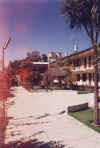 Our truffi (van) driver Raul is also an old friend from our last trip, and we greet him
warmly.Raul loads our bags and drives us to the town of Vinto, 20 minutes west of Cochabamba, to the Casa de
Retiros.The Casa de Retiros is just as I remembered – a large motel-like complex within a 3-acre walled compound. Outside are
soft yellow stucco walls and tile walkways angling through large grassy quilts
adorned with fragrant hibiscus and rose bushes.A few latticed wood gazebos provide gathering places shaded from the
intense late afternoon sun.
Our truffi (van) driver Raul is also an old friend from our last trip, and we greet him
warmly.Raul loads our bags and drives us to the town of Vinto, 20 minutes west of Cochabamba, to the Casa de
Retiros.The Casa de Retiros is just as I remembered – a large motel-like complex within a 3-acre walled compound. Outside are
soft yellow stucco walls and tile walkways angling through large grassy quilts
adorned with fragrant hibiscus and rose bushes.A few latticed wood gazebos provide gathering places shaded from the
intense late afternoon sun.
Marvin and I share a 9’ x 14’ room that sleeps 5 with 2 bunk beds and one single bed.The beds have 3” high stuffed mattresses that have obviously led a hard life.Each bed has 3 thick woolen blankets to protect from temperatures that drop into the 40’s at night.There is no heating or air conditioning here at Casa de Retiros, or anywhere in the Cochabamba area.You live very close to the outdoors, windows and doors open to welcome the warming sun during the day, closed tightly against the chilling nights.
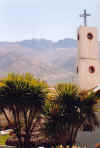
The view from our room is incredible.The mountains are so close you can feel your breath against them.Imposing and sharply angular against the solid blue sky, their color and deep numerous folds reminds me of vast wrinkles of elephant skin.At the base of the mountains are the adobe and brick houses of Bolivian farmers, sturdy among the patchwork fields of alfalfa, carrots, potatoes and corn.Life is hard here in the midst of breathtaking beauty.
June 2, 2003
After our first night’s sleep at Casa de Retiros, we have a traditional Bolivian breakfast of bread and coffee or tea, and then we are off to the orphanage – Hogar de los Ninos.We’ve a week of work ahead, building the second floor of quarters for the nuns who care for the orphans.
 I’m amazed to see the building progress since we were last here.One and a half years ago the
I’m amazed to see the building progress since we were last here.One and a half years ago the
 dining room, kitchen and storage areas were
just a brick shell.Now they are completely roofed and finished, with smooth light apricot walls and large,
glossy terra cotta floor tiles.The dining room has a pass through window to the kitchen, and 10 round wood tables
with embroidered tablecloths, and each table with 6 wood chairs.The large airy kitchen would be a dream for any
homeowner, with 2 walls of counter and cabinets, 2 large freezers and a refrigerator against the third
long wall, and 2 large stoves and a worktable in the center.I indulge in a small measure of satisfaction for the minor role we played
in constructing this building.
dining room, kitchen and storage areas were
just a brick shell.Now they are completely roofed and finished, with smooth light apricot walls and large,
glossy terra cotta floor tiles.The dining room has a pass through window to the kitchen, and 10 round wood tables
with embroidered tablecloths, and each table with 6 wood chairs.The large airy kitchen would be a dream for any
homeowner, with 2 walls of counter and cabinets, 2 large freezers and a refrigerator against the third
long wall, and 2 large stoves and a worktable in the center.I indulge in a small measure of satisfaction for the minor role we played
in constructing this building.
 But our project for the next two weeks appears far more daunting.The 2nd floor of the nuns’ quarters/administration building
is merely a concrete slab floor with steel rods poking up here and there.Over the next two weeks, we are to bend rebar and form wire columns,
turning them into concrete columns, and build brick walls around the outside of the second floor.There’s some serious construction to be done here!
But our project for the next two weeks appears far more daunting.The 2nd floor of the nuns’ quarters/administration building
is merely a concrete slab floor with steel rods poking up here and there.Over the next two weeks, we are to bend rebar and form wire columns,
turning them into concrete columns, and build brick walls around the outside of the second floor.There’s some serious construction to be done here!
We have Bolivian construction workers to teach and help us.Felix, the maestro, is a seasoned mason and a patient leader.He has 3 helpers – Rolando and Jorge, at 20 and 16 respectively, are overjoyed to find 2 young women in the workgroup.They are serious workers, but they love talking and joking with Lisa and Andrea.Sebastian, age unknown, speaks mostly Quechuan, but is a quiet and steady worker.
June 7, 2003
During
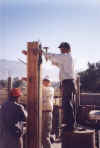 our first week we all do various jobs.We form rebar stirrups using steel tubes to hold the rebar and fixed nails on wood to
bend the stirrups around.We anchor the stirrups to the steel columns with wire and pliers,
our first week we all do various jobs.We form rebar stirrups using steel tubes to hold the rebar and fixed nails on wood to
bend the stirrups around.We anchor the stirrups to the steel columns with wire and pliers, and then construct wood
forms around them.We shovel sand into stretched wire mesh to sift it for making cement.And we carry bucket after bucket of cement to pour into the wooden forms
to make the cement columns.When the concrete columns have hardened, we begin laying bricks around the outside
walls.We have to keep the bricks water
ed down, mix the mezcla (cement mixture) to just the right texture, slather the wall with mezcla using our patos (trowels), and ease the brick into its rightful place at just the correct height
and angle.It’s slow going, and I find with dismay that it takes an hour to do each row. Nevertheless, gradually, in the beating sun, the wall slowly rises.
and then construct wood
forms around them.We shovel sand into stretched wire mesh to sift it for making cement.And we carry bucket after bucket of cement to pour into the wooden forms
to make the cement columns.When the concrete columns have hardened, we begin laying bricks around the outside
walls.We have to keep the bricks water
ed down, mix the mezcla (cement mixture) to just the right texture, slather the wall with mezcla using our patos (trowels), and ease the brick into its rightful place at just the correct height
and angle.It’s slow going, and I find with dismay that it takes an hour to do each row. Nevertheless, gradually, in the beating sun, the wall slowly rises.
We take a long weekend – go to La Cancha, the huge open air market in Cochabamba , ride the cable car up the mountain to see the huge statue of the Cristo, ride to the rainforest and hike to a river and waterfall. We have good food and wine at some fancy restaurants.And in no time at all the weekend is over and we’re back at work.
June 13, 2003
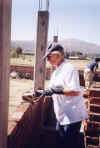 The second week is harder.Bodies protest against inadequate rest time and continued heavy labor, aching all the way through the
night.But the brick walls slowly grow higher, and the floor is filling up with cement columns.I urge my body to hang on just a little longer to finish
this job or that, as I can now imagine rooms and walls and windows where once there was only floor.We are as grimy, hot and
tired as we can be, but we are hanging in there.
The second week is harder.Bodies protest against inadequate rest time and continued heavy labor, aching all the way through the
night.But the brick walls slowly grow higher, and the floor is filling up with cement columns.I urge my body to hang on just a little longer to finish
this job or that, as I can now imagine rooms and walls and windows where once there was only floor.We are as grimy, hot and
tired as we can be, but we are hanging in there.
And finally the last day arrives. Three of the 4 walls almost reach the ceiling.La pared del infierno (the wall from hell), which we’ve dubbed for its uncanny ability to sag askance no matter how many times we remove the bricks and start over, has been adopted by Felix, who finishes is with the easy aplomb of his skill and years of experience.
We celebrate with the nuns, the orphans and the masons.In the beautiful dining room
 we serve everyone bunuelos
(deep fried buns) and empañadas with a sweet hot corn drink.The child
ren’s eyes are glistening with excitement; they steal occasional glances at the gringos, or shyly nudge their
friends and make furtive comments.The 3 and 4-year-olds take the longest, making every bit last forever, the syrup now
sticky on their tiny hands and smudged into their sleeves.There are seconds and thirds for those with the biggest appetites.
we serve everyone bunuelos
(deep fried buns) and empañadas with a sweet hot corn drink.The child
ren’s eyes are glistening with excitement; they steal occasional glances at the gringos, or shyly nudge their
friends and make furtive comments.The 3 and 4-year-olds take the longest, making every bit last forever, the syrup now
sticky on their tiny hands and smudged into their sleeves.There are seconds and thirds for those with the biggest appetites.
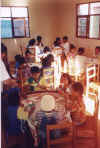 Then we all move to the classroom/play area where some of the older children have prepared to perform traditional Bolivian dances.Waving
their handkerchiefs smartly
Then we all move to the classroom/play area where some of the older children have prepared to perform traditional Bolivian dances.Waving
their handkerchiefs smartly
 in the air, they bounce lightly back and forth with a combination swaying and hopping step.The intensity in their faces is heartwarming.Here
in the scenic heart of Bolivian, among the parched, dusty farmlands, in a small set of simple brick buildings, some orphans and abandoned children have a
special morning to laugh, eat and celebrate for a few hours.They deserve more than this, but this is what life has allowed them, and they make the most of it.
in the air, they bounce lightly back and forth with a combination swaying and hopping step.The intensity in their faces is heartwarming.Here
in the scenic heart of Bolivian, among the parched, dusty farmlands, in a small set of simple brick buildings, some orphans and abandoned children have a
special morning to laugh, eat and celebrate for a few hours.They deserve more than this, but this is what life has allowed them, and they make the most of it.
 Then, suddenly, we load all the tools in our truffi and set off, waving wildly to the children at one gate,
waving again as we round the corner and they have all run to the second gate.Joyce, Andrea and Lisa wonder aloud whether their busy lives
and schedules will allow them to return – they’d clearly like to.Marvin and I sit calm and satisfied with the assurance we’ll return
with another work group in just six weeks.We’re ready to rest our bodies, sink back a little into our new life in
Cochabamba, whatever that may turn out to be.But we know we’ll be back to the orphanage, and there’s a warm core
of promise that melts over me with the knowing.
Then, suddenly, we load all the tools in our truffi and set off, waving wildly to the children at one gate,
waving again as we round the corner and they have all run to the second gate.Joyce, Andrea and Lisa wonder aloud whether their busy lives
and schedules will allow them to return – they’d clearly like to.Marvin and I sit calm and satisfied with the assurance we’ll return
with another work group in just six weeks.We’re ready to rest our bodies, sink back a little into our new life in
Cochabamba, whatever that may turn out to be.But we know we’ll be back to the orphanage, and there’s a warm core
of promise that melts over me with the knowing.
June 21, 2003
 Our “permanent” home here in Cochabamba is a 3-floor tan stucco house on a busy street in the
north end of the city where the mountains have already begun their slow rise to the sky.Like many Bolivian homes,
our house hides behind a high stonewall with a locked gate.Inside the wall is a small neat front lawn sprinkled with jasmine, roses
and gardenias.The slightly larger back yard contains mandarin orange trees and 3 dogs, one a huge German shepherd
named Bronson that Marvin is going all out to become friends with.
Our “permanent” home here in Cochabamba is a 3-floor tan stucco house on a busy street in the
north end of the city where the mountains have already begun their slow rise to the sky.Like many Bolivian homes,
our house hides behind a high stonewall with a locked gate.Inside the wall is a small neat front lawn sprinkled with jasmine, roses
and gardenias.The slightly larger back yard contains mandarin orange trees and 3 dogs, one a huge German shepherd
named Bronson that Marvin is going all out to become friends with.
 We enter the house at the side, through a wide dark wood door and step into a sunny foyer with a
We enter the house at the side, through a wide dark wood door and step into a sunny foyer with a shiny white and gray marbled floor.To the right, an open living area and sunken dining room boast creamy white walls
and modern cushioned wood furniture in soothing browns and tans. Straight ahead, through another dark wood door is a large tiled kitchen
with a small wooden table and chairs where we eat breakfast, and evening suppers.
shiny white and gray marbled floor.To the right, an open living area and sunken dining room boast creamy white walls
and modern cushioned wood furniture in soothing browns and tans. Straight ahead, through another dark wood door is a large tiled kitchen
with a small wooden table and chairs where we eat breakfast, and evening suppers.
The family (Jean Carla Costa – the director of the Amizade program in Bolivia, her son Andres, and her
 mother Lucy) lives in 5 large rooms upstairs, but our quarters are just to the left of the foyer.First, a
small bedroom with a large wardrobe and two twin beds filling all the room space.Then, through glass doors
into an L-shaped sitting room with a panoramic view of the city below and the southern mountains rising behind.At
night the mountains fade into the dark, and the city sparkles and glistens in a twinkling carpet of lights,
mother Lucy) lives in 5 large rooms upstairs, but our quarters are just to the left of the foyer.First, a
small bedroom with a large wardrobe and two twin beds filling all the room space.Then, through glass doors
into an L-shaped sitting room with a panoramic view of the city below and the southern mountains rising behind.At
night the mountains fade into the dark, and the city sparkles and glistens in a twinkling carpet of lights,
 the distant illuminated statue of the Cristo blessing the city from its small mountain perch.But the sitting room grows chilly by early evening, and
barely reaches 60 degrees during the warm days, not even close to cozy enough to overcome its enticing views.Now,
during the heart of winter in the southern hemisphere, we opt to spend mornings in the sunny living room on the north side of the house.(Jean Carla tells us that many years ago some U. S. architects came to
Bolivia to teach architecture, and mistakenly taught their students to build the wide, scenic
the distant illuminated statue of the Cristo blessing the city from its small mountain perch.But the sitting room grows chilly by early evening, and
barely reaches 60 degrees during the warm days, not even close to cozy enough to overcome its enticing views.Now,
during the heart of winter in the southern hemisphere, we opt to spend mornings in the sunny living room on the north side of the house.(Jean Carla tells us that many years ago some U. S. architects came to
Bolivia to teach architecture, and mistakenly taught their students to build the wide, scenic
 windows on the south side.Quite a few buildings were actually built before the error was discovered.)With temperatures reaching around 80 at midday and around 40 at night,
and with no heating and air conditioning, finding the sunny spots in any building is a matter of genuine comfort.We’re
close enough to the equator that the sun both rises and sets around 6:00, so the long chilly evenings mean multiple layers of clothing.It’s like living outdoors, only with indoor furniture.
windows on the south side.Quite a few buildings were actually built before the error was discovered.)With temperatures reaching around 80 at midday and around 40 at night,
and with no heating and air conditioning, finding the sunny spots in any building is a matter of genuine comfort.We’re
close enough to the equator that the sun both rises and sets around 6:00, so the long chilly evenings mean multiple layers of clothing.It’s like living outdoors, only with indoor furniture.
Here’s Marvin’s version of our quaint bathroom: I am Gulliver in the land of Lilliput.I could not hide in a crowd were my life to depend on it. Most people on the street come no higher than my shoulder. A 6 foot 2 inch (188 cm) blue-eyed blond can forget about blending in. A walk down the sidewalk cannot be a straight line as I duck under trees trimmed at my eye level and around vendors’ umbrellas. Should the police fire over the heads of an unruly crowd, I’m a dead man.
But fear not, for in our home is a get-down, think small device. Martie has referred to it as “the quaint” bathroom. Let me describe “quaint”.
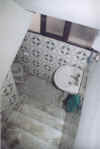 When the original house was renovated to provide rentable space, the inside stairway to the
When the original house was renovated to provide rentable space, the inside stairway to the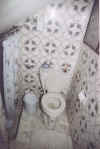 basement was converted into a ¾ bath. Open
the door and go down three stairs to the former landing. This level is 6’ 6” by 3’.The basin is on the right wall and the toilet on the left.The sloping ceiling down the stairs is 6’ 0”, as is the level ceiling
above the sink, but the ceiling over the toilet slopes down as if continuing to the basement.
basement was converted into a ¾ bath. Open
the door and go down three stairs to the former landing. This level is 6’ 6” by 3’.The basin is on the right wall and the toilet on the left.The sloping ceiling down the stairs is 6’ 0”, as is the level ceiling
above the sink, but the ceiling over the toilet slopes down as if continuing to the basement.
Reverse directions and take two steep steps down from the toilet and you are in the shower.The shower stall is about 3’ X 3’.Where the curtain closes between you and the toilet the ceiling is 6’, but at the back of the shower stall it slopes to 4’ 3”.The showerhead rests on the curtain rod and provides a copious supply of hot water.This bathroom is an ingenious use of space.As an engineer I appreciate the effort required to slip all of this into the confines of a stairwell.
Picture, if you will, old Marv getting ready for the day.I open the door, sidle down the stairs with my hair telling me how far back to lean.Nothing noteworthy about settling onto the throne with a good book, but it does take your mind away from your surroundings. Habit takes over as I arise, hoisting my drawers – remember that sloping ceiling? I don’t. And it’s CONCRETE!
To shower, I have to holler loud enough for the family to hear “Entrando la ducha!” This alerts the family upstairs not to flush or otherwise upset the delicate water pressure balance.Forget the warning and your punishment is to be alternately parboiled and frozen. With the water properly adjusted, it is a simple matter to step down two steps and begin lathering.It is impossible to stand. My posture varies between Cro-Magnon Man and Quazimoto, as I seek to water various body areas.Any unplanned move usually makes me wish I hadn’t.
Toweling off is easy.I do each leg as I come up the stairs. Since I am bent over the toilet at that point, I am reminded not to straighten up. By stepping in front of the sink where I only have to shrink two inches, I finish drying in relative comfort.
The mirror over the sink is placed so I could shave my chest hair, if I had any. So the final shaving ritual is performed in a crouch.And if I forgot a bowl to transfer hot water from the shower, I get to shave in cold.No bathroom sink in Bolivia has hot water.
So you see, as I use this “quaint” bathroom over the next few months, I expect the headaches to abate as I hunker down, shorten up and blend in.
We eat well here, having an abundance of fresh fruits and vegetables.With the exception of meats, most foods are not prepared with fats.But eating well requires flexibility.There are marvelous fruits and juices of banana, papaya, mango, mandarin orange, avocado, tumbo, chirimoya, pomegranate and quince. But you can’t buy straight orange or apple juice in the grocery store – it’s always mixed with soymilk.
Vegetables are even more plentiful – tomatoes, carrots, onions, yucca, many varieties of potatoes, fava beans, peas, green beans, beets, broccoli, hearts of palm, cauliflower and lots of assorted squashes.But with the exception of potatoes, yucca and some of the squashes, vegetables are boiled, then served cold.
We’ve had marvelous soups made with vegetables, oatmeal, quinoa and even a rich and savory peanut soup.Salads are eaten without any dressing, there’s only one brand of mustard, pickles are not pickled, and there’s no such thing as decaf coffee. Cheeses are semi-soft, salty, and nothing like those in the U. S.Milk and mayonnaise come in flexible opaque plastic bags, like a Ziploc bag full of water.We hardly ever have ice, because water sources must always be questioned.Bread and rice are staples.It’s a new way of eating – fun, experimental, sometimes a disappointment, but usually delicious.And my favorite part of all is the array of Bolivian-made wines at a mere $2.00 US per bottle.
We walk often to the grocery stores, Internet cafes, and photo shops 20 – 40 minutes away, always down the gradual mountain slope, along busy city street with intermittent and grossly uneven sidewalks. The missing and broken sidewalks require our total attention to keep from falling and they distract us from drinking in the colorful bougainvillea, smelling the fragrant eucalyptus trees, and peering into small walled shops with intriguing wafting smells.The only unfortunate thing about living partway up the mountain is the slow agonizing trudge back up, the high altitude tearing the breath from our lungs and refusing to give it back.
Imagine living with no car, PC, TV, radio or CD player in your house.Imagine what you’d do with your time and how precious people and books would become.Now, before we branch out to work and meet people throughout the city, before we make more friends and learn more Spanish and know our way around, our lives are small and sequestered, devoid of all previously known ways to reach family, friends, the news of the world we left behind.Even the Internet Spam takes on a more welcome, friendly nature, in a hunger to connect with someone outside ourselves.
Two weeks ago I mailed a postcard of a llama to our granddaughter Jaevyn.I used the only method available to mail it.I took a bus to the huge downtown post office (no branch post offices or mail boxes available in this city of 800,000), bought the necessary stamp, and dropped the card in the appropriate slot in a long wooden wall.Then I peered over the wall to see where my card had gone, and saw it on top of a pile of letters and cards nestled in a huge plastic laundry basket.I wonder if it will ever arrive.
During our first week here, we visited the Virgin of Urkupina, along with the other Amizade volunteers.In a strange twist of religious practice, the Virgin of Urkupina grants requests for material goods such as cars, homes and riches.To savor the true experience, Marvin and I asked for a job for our daughter Anne, who will be a new college graduate in August.Little did we know the combination of Catholic, Quechua and Aymara rituals involved. First, I accepted a small brightly colored cloth bag draped around my neck and stuffed with play money and other symbolic trinkets Accompanied by Marvin and my new cloth bag, I carried two candles up 200 yards of stairs to the Virgin’s open-air chapel and lit the candles at the altar. We then descended and were bathed in incense by a Bolivian woman who waved an incense pot around us, chanting and praying simultaneously to the Virgin and the Pachamana (earth mother). Following a brief group hug, we squirted foamy beer sideways toward the Virgin and onto the ground for the Pachamana, finishing with a small sip for ourselves.A final prayer, then we were released to return home with our cloth bags We must guard them carefully for a year, after which we bury them, whether Anne gets her job or not. Believing, cautioned the Bolivian woman, is the most important thing.
To continue reading click here for page 2 of 3: Bolivia 2003 continues

